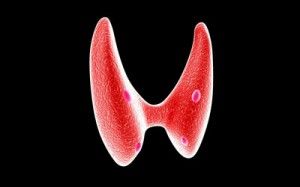Thyroid Surgery
 The thyroid gland is a butterfly-shaped gland that lies in front of the trachea in the lower neck. The two sides, or glands, are joined in the middle by a ridge of thyroid tissue called the isthmus. The thyroid gland usually cannot be seen unless it is enlarged. The main function of the thyroid gland is to make and secrete thyroid hormone, which helps control all other hormones in the body. It is a major controller of metabolism and is often considered the body’s thermostat.
The thyroid gland is a butterfly-shaped gland that lies in front of the trachea in the lower neck. The two sides, or glands, are joined in the middle by a ridge of thyroid tissue called the isthmus. The thyroid gland usually cannot be seen unless it is enlarged. The main function of the thyroid gland is to make and secrete thyroid hormone, which helps control all other hormones in the body. It is a major controller of metabolism and is often considered the body’s thermostat.
There are many disorders of the thyroid gland that can occur, and most do not require surgery. Thyroid problems that may necessitate surgery include hyperthyroidism resistant to medical management, an enlarged thyroid gland that is causing symptoms, suspicious thyroid nodules, and thyroid cancer.
Excess production of thyroid hormone by the thyroid gland is termed hyperthyroidism. Most diseases and problems that cause hyperthyroidism are treated medically, but occasionally surgical management may be necessary. Hyperthyroid states most commonly considered for surgery are Grave’s disease, multinodular goiter, and a hyperactive solitary thyroid nodule.
Thyroid Conditions Treated
Goiter
Grave’s Disease
Hyperthyroidism
Thyroid Cancer
Thyroid Nodules
Thyroid Surgery
When it comes time for your surgery, you will be placed under general anesthesia and IV fluid support. An incision will be made along the base of the neck, through which the surgeon will remove part or all of the thyroid gland. Once the gland has been removed, the doctor will close the incision with a dissolvable suture and place a paper bandage over the wound.
After you are taken out of the operating room, you will be taken to a recovery room to make sure that you come out of anesthesia without any complications. After you have been cleared, your driver will be able to take you home to begin your recovery process in most cases. You may need to spend the night in the hospital for higher risk patients.
After your Thyroid Surgery
- Pain should be minimal following your surgery. It is usually adequately controlled with Ibuprofen or Tylenol. If these medications are not sufficient, do not hesitate to use the narcotic pain medication given to you prior to surgery. Be sure to also use an over the counter stool softener, due to narcotics’ tendencies to cause constipation.
- You may shower the day after surgery. Expect your incision to be firm, pink and raised over the next couple weeks and mild bruising around the lower neck and upper chest.
- Your voice will appear hoarse after surgery, and some patients experience a voice fatigue near the end of the day. Both of these symptoms usually resolve within 2-3 months.
- Hypocalcemia (low calcium level) is a common complication of thyroid surgery, generally occurring 2-3 days afterward. Symptoms may include numbness or tingling in the lips or fingertips, muscle twitching, and headaches. Treatment is with either 2 Regular Strength (500mg) Tums tablets 3 times daily OR 1 Ultra Strength (1000mg) Tums tablet 2 times daily. It is best to have these on hand prior to returning home from the hospital.
Related Thyroid Information
Did You Know? – The Common and Uncommon Symptoms of Thyroid Disorders
Understanding your thyroid health can be a complex task. The thyroid, a small gland in your neck, plays a significant role in your overall health by controlling the rate of many activities in your body. But what happens when it starts to malfunction? Dr. Richard Fox, a board-certified general surgeon [...]
